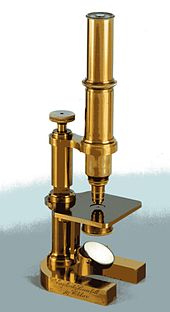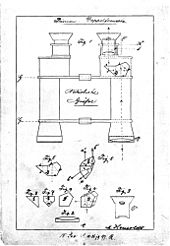Moritz Hensoldt
Moritz Carl Hensoldt (born November 11, 1821 in Lindenau , Thuringia , † October 10, 1903 in Wetzlar ) was a German entrepreneur and is considered a pioneer in optics . He was a co-founder of the optical-precision engineering industry in Wetzlar.
Life
Moritz Hensoldt was born on November 11, 1821 in Lindenau, Thuringia (today a district of Heldburg ) as the son of the later ducal official secretary Heinrich Christoph Hensoldt and his wife Karoline Margarethe nee. Angels who moved to Sonneberg (Thuringia) with their children after 1829 .
In Saalfeld, Hensoldt was trained as a precision mechanic by the coin mechanic and engraver Andreas Wiskemann , left the apprenticeship early with the journeyman's certificate because of his good performance and then worked first in Kassel at the company FW Breithaupt (1842/43), later in Hamburg at A. & G. Repsold . There he met Carl Kellner in the spring of 1846 , whose workshop was taken over by Ernst Leitz after his death in 1870 .
A deep friendship developed between the two very different men, which determined the next few years of their lives.
Endowed with the same interests and skills, Kellner and Hensoldt tried a total of three times to found a joint workshop and to work together in it. However, their fundamentally different nature is the reason why each of their attempts has failed. Nevertheless, the six years of their friendship, documented in 44 received letters that Carl Kellner Moritz Hensoldt wrote between 1846 and 1852, shaped both men and significantly influenced their work. This is especially true for Hensoldt, who outlived his friend who died early by almost 50 years.
Moritz Hensoldt met his future wife Christine Ohlenburger, a cousin of Mathilde and Carl, in the house of Carl Kellner's sister Mathilde Hinckel, and married in 1854 in Sonneberg.
Shortly after his return from Hamburg he founded a small workshop in Sonneberg on April 15, 1847 (later Hensoldt AG ). The official founding date of the Hensoldt company, April 1, 1852, can no longer stand up to the latest findings. On October 1, 2006, for having Zeiss belonging group Wetzlar Hensoldt AG in Carl Zeiss Sports Optics GmbH renamed.
The great bond with their father may be one of the reasons that the couple initially stayed in the Sonneberg area. The stations there are Oberlind and Neustadt bei Coburg , where Hensoldt each owned a house with a workshop. The couple's first of the nine children, seven of whom remained alive, were born there.
The death of his father in September 1859 and the ties that both had with the Wetzlar area were probably the reason that Moritz Hensoldt and another cousin of his wife, the mechanic and optician Louis Engelbert from Oberndorf , whom he had from his stays in Wetzlar knew, founded the Engelbert & Hensoldt company in Braunfels in 1861 , which soon made a name for itself with the construction of microscopes .
At the end of 1865 the two families finally moved to Wetzlar.
It was there that Hensoldt began to build telescopes under his own name in 1877, primarily telescopes , but remained connected to Engelbert in business and friendship until his death in 1887.
The following years were characterized by a steady rise in what was initially a purely craft business.
Moritz Hensoldt made a name for himself in the professional world with a number of in-house developments, especially in the field of binoculars - and the geodetic sector. From 1880 the company supplied the British and later the German army on a large scale with its products.
The company also made a name for itself early on in the field of telescopes, later binocles ( double telescopes ), for private and hunting use, astronomical telescopes and measuring instruments. The business successes were also the reason for the construction of a stately new factory in 1895 on Sophienstrasse.
In 1896 his sons Waldemar and Carl became partners in the company. Moritz Hensoldt went about his work every day until the end.
On October 10, 1903, at the age of almost 82, he followed his wife Christine, who had died in the spring. An obituary on the occasion of the company's centenary in 1952 states:
“He was a simple, quiet and unassuming man who fully lived his scientific work. His memory still has an effect today among his professional colleagues, who counted him, the capable and honest master of old shot and grain, among the best and first who have ever been a mechanic and optician. "
Moritz Hensoldt's inventions and new designs
- 1877/78: Reading microscope, an instrument that is used extensively in measuring instruments. It is used for precise circle readings ( theodolites , meridian circles ).
- 1879: Dial rangefinder for military purposes
- 1880: Orthoscopic eyepiece , a further development of Carl Kellner's eyepiece
- 1892/93: Basic rangefinder together with the Beaulieu-Hahn company in Kassel, in whose construction Hensoldt took up an old idea in his correspondence with Kellner, namely to use image-inverting prism combinations
- from 1897: Prism double telescopes with five-sided pentaprism , which with its double reflection provides the so-called “standing image” and the telescope is considerably simplified in its construction, and also allows the use of large lenses which increase the light intensity considerably
- 1899: small range finder, a pentagon angle prism
- from 1900: Binocular telescope with dialytic system, a combination of the so-called dialytic objective system with a pentaprism provided with a roof edge with the aim of shortening the beam path in the binoculars (handy size). With an objective diameter of 35 mm at five times magnification, an intensive increase in light intensity has taken place.
- 1902: Prismatic riflescope for rifles: The newly designed roof prisms used here for the first time enabled a straight axis beam without parallel displacement .
Note: Around 1900 it was only possible for the Hensoldt company to manufacture prisms with roof edges in series. The sensitivity of the roof edge, which manifests itself in double contours with a deviation of only a few seconds, made it necessary to create our own test instruments.
The special prism construction of the riflescope was later successfully used in the prism telescope, the Hensoldt Dialyt, developed by Hensoldt's youngest son Carl from 1906 .
literature
- Carl Hensoldt: The Hensoldt factory and its relationship to general telescope technology . Wetzlar 1908.
- Ernst Voege: 100 years of M. Hensoldt & Sons . Darmstadt 1952.
- Roland Leinhos: Hensoldt, Moritz Carl. In: New German Biography (NDB). Volume 8, Duncker & Humblot, Berlin 1969, ISBN 3-428-00189-3 , p. 565 f. ( Digitized version ).
- Christine Belz-Hensoldt (Ed.): Apprenticeship and wandering years. Moritz Hensoldt's letters to his father from 1838–1843 . Paque Verlag, Ramstein-Miesenbach 2002.
- Karsten Porezag: Hensoldt Vol. 1: Family and founding history up to 1903 , Wetzlar 2001, ISBN 3-9807950-0-4
Web links
- Literature by and about Moritz Hensoldt in the catalog of the German National Library
- Hensoldt, Moritz Carl. Hessian biography. (As of August 26, 2013). In: Landesgeschichtliches Informationssystem Hessen (LAGIS).
- Museum of Optical Instruments: Microscopes : Small microscope by Engelbert u. Hensoldt in Braunfels, No. 91
Individual evidence
- ↑ see Hessisches Staatsarchiv Marburg (HStAMR), Best. 911 No. 7561, p. 172 ( digitized version ).
| personal data | |
|---|---|
| SURNAME | Hensoldt, Moritz |
| ALTERNATIVE NAMES | Hensoldt, Moritz Carl |
| BRIEF DESCRIPTION | German entrepreneur and optics pioneer |
| DATE OF BIRTH | November 11, 1821 |
| PLACE OF BIRTH | Lindenau , Thuringia |
| DATE OF DEATH | October 10, 1903 |
| Place of death | Wetzlar |





